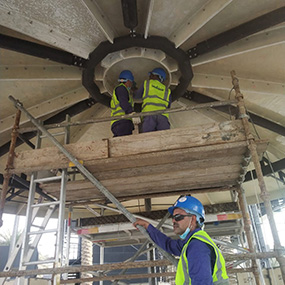
When it comes to industrial and construction applications, the selection of materials is crucial in determining the overall success, durability, and efficiency of projects. With many benefits over conventional materials like iron and steel, glass reinforced plastic, or GRP, has become a strong competitor over time. Let us explore the unique benefits that GRP products offer, transforming the face of different industries.
The remarkable strength-to-weight ratio of GRP products is one of their most notable qualities. Because of its extreme light weight, GRP is the perfect material for applications where a reduction in total weight is essential. GRP is incredibly strong despite being lightweight, outperforming conventional materials like steel and iron in particular applications.
In industries that use a lot of iron and steel, corrosion is a constant problem. Conversely, GRP has an innate ability to withstand corrosion. Because of this characteristic, GRP products are extremely durable and drastically lower maintenance costs over the course of equipment and structure life. In harsh environments, like the marine or chemical processing industries, GRP products are revolutionary in addressing corrosion-related problems.
GRP provides unmatched design flexibility, enabling the construction of complex and personalised structures. In contrast to steel and iron, which frequently have predetermined shapes, GRP is virtually form-fitting. Its adaptability gives engineers and architects new options to work with, allowing them to create creative and beautiful designs.
GRP has superior thermal insulation qualities. This feature is especially helpful in situations where temperature control is essential, like in the building of energy-efficient structures or chemical processing facilities. The properties of GRP that provide thermal insulation help to reduce energy consumption and improve the overall effectiveness of a variety of applications.
Over time, materials' structural integrity and surface quality can deteriorate due to exposure to ultraviolet (UV) radiation. Nonetheless, GRP products are naturally resistant to UV light. GRP structures and components are suitable for outdoor applications because of this resistance, which guarantees that they keep their strength and appearance even after being exposed to intense sunlight.
The long-term cost advantages of GRP products are significant, even though their initial cost may be somewhat more or equal to that of traditional materials. Over the course of a GRP structure's lifespan, the resistance to corrosion and the minimal maintenance requirements result in significant savings. GRP is ultimately a more affordable option due to its lower installation and maintenance expenses.
GRP is an extremely environmentally friendly material that is highly sustainable. Less resources are used in the production of GRP than in the processes used to make iron and steel. Furthermore, GRP's recyclable nature makes it a more ecologically friendly method that fits in with the increasing focus on sustainable practises across a range of industries.
In conclusion, the advantages of GRP products over iron and steel are reshaping the way industries approach construction, infrastructure, and manufacturing. The unique combination of strength, corrosion resistance, design flexibility, and environmental sustainability positions GRP as a superior choice in diverse applications. As industries continue to prioritize efficiency, longevity, and cost-effectiveness, the adoption of GRP products is set to grow, marking a paradigm shift in materials selection for a brighter, more sustainable future.
Copyright © 2023 All rights reserved.
